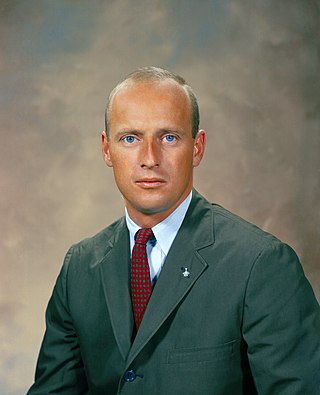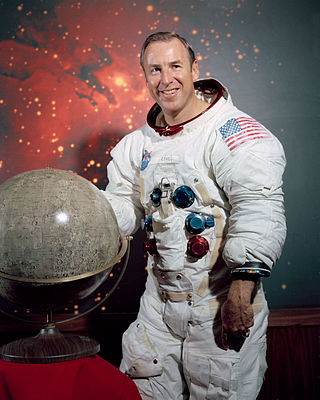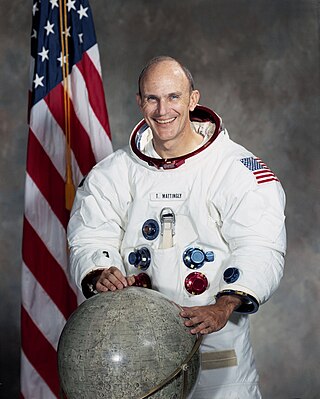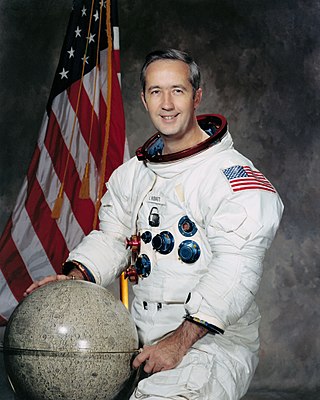
The Apollo program, also known as Project Apollo, was the third United States human spaceflight program carried out by the National Aeronautics and Space Administration (NASA), which succeeded in preparing and landing the first humans on the Moon from 1968 to 1972. It was first conceived in 1960 during President Dwight D. Eisenhower's administration as a three-person spacecraft to follow the one-person Project Mercury, which put the first Americans in space. Apollo was later dedicated to President John F. Kennedy's national goal for the 1960s of "landing a man on the Moon and returning him safely to the Earth" in an address to Congress on May 25, 1961. It was the third US human spaceflight program to fly, preceded by the two-person Project Gemini conceived in 1961 to extend spaceflight capability in support of Apollo.

Apollo 12 was the sixth crewed flight in the United States Apollo program and the second to land on the Moon. It was launched on November 14, 1969, by NASA from the Kennedy Space Center, Florida. Commander Charles "Pete" Conrad and Lunar Module Pilot Alan L. Bean performed just over one day and seven hours of lunar surface activity while Command Module Pilot Richard F. Gordon remained in lunar orbit.

Extravehicular activity (EVA) is any activity done by an astronaut in outer space outside a spacecraft. In the absence of a breathable Earthlike atmosphere, the astronaut is completely reliant on a space suit for environmental support. EVA includes spacewalks and lunar or planetary surface exploration. In a stand-up EVA (SEVA), an astronaut stands through an open hatch but does not fully leave the spacecraft. EVA has been conducted by the Soviet Union/Russia, the United States, Canada, the European Space Agency and China.

Charles "Pete" Conrad Jr. was an American NASA astronaut, aeronautical engineer, naval officer and aviator, and test pilot, and commanded the Apollo 12 space mission, on which he became the third person to walk on the Moon. Conrad was selected for NASA's second astronaut class in 1962.

Eugene Andrew Cernan was an American astronaut, naval aviator, electrical engineer, aeronautical engineer, and fighter pilot. During the Apollo 17 mission, Cernan became the eleventh human being to walk on the Moon. As he re-entered the Apollo Lunar Module after Harrison Schmitt on their third and final lunar excursion, he remains the last person to walk on the Moon.

John Watts Young was an American astronaut, naval officer and aviator, test pilot, and aeronautical engineer. He became the 9th person to walk on the Moon as commander of the Apollo 16 mission in 1972. He is the only astronaut to fly on four different classes of spacecraft: Gemini, the Apollo command and service module, the Apollo Lunar Module and the Space Shuttle.

David Randolph Scott is an American retired test pilot and NASA astronaut who was the seventh person to walk on the Moon. Selected as part of the third group of astronauts in 1963, Scott flew to space three times and commanded Apollo 15, the fourth lunar landing; he is one of four surviving Moon walkers and the only living commander of a spacecraft that landed on the Moon.

Walter Marty Schirra Jr. was an American naval aviator, test pilot, and NASA astronaut. In 1959, he became one of the original seven astronauts chosen for Project Mercury, which was the United States' first effort to put human beings into space. On October 3, 1962, he flew the six-orbit, nine-hour, Mercury-Atlas 8 mission, in a spacecraft he nicknamed Sigma 7. At the time of his mission in Sigma 7, Schirra became the fifth American and ninth human to travel into space. In the two-man Gemini program, he achieved the first space rendezvous, station-keeping his Gemini 6A spacecraft within 1 foot (30 cm) of the sister Gemini 7 spacecraft in December 1965. In October 1968, he commanded Apollo 7, an 11-day low Earth orbit shakedown test of the three-man Apollo Command/Service Module and the first crewed launch for the Apollo program.

James Arthur Lovell Jr. is an American retired astronaut, naval aviator, test pilot and mechanical engineer. In 1968, as command module pilot of Apollo 8, he became, with Frank Borman and William Anders, one of the first three astronauts to fly to and orbit the Moon. He then commanded the Apollo 13 lunar mission in 1970 which, after a critical failure en route, circled the Moon and returned safely to Earth.

Thomas Kenneth Mattingly II is an American former aviator, aeronautical engineer, test pilot, rear admiral in the United States Navy and astronaut who flew on the Apollo 16, STS-4 and STS-51-C missions.

Ronald Ellwin Evans Jr. was an American electrical engineer, aeronautical engineer, officer and aviator in the United States Navy, and NASA astronaut. As Command Module Pilot on Apollo 17 he was one of the 24 astronauts to have flown to the Moon, and one of 12 people to have flown to the Moon without landing.

Richard Francis Gordon Jr. was an American naval officer and aviator, test pilot, and NASA astronaut, and a football executive. He was one of 24 people to have flown to the Moon, as command module pilot of the 1969 Apollo 12 mission, which orbited the Moon 45 times. Gordon had already flown in space as the pilot of the 1966 Gemini 11 mission.

James Alton McDivitt was an American test pilot, United States Air Force (USAF) pilot, aeronautical engineer, and NASA astronaut in the Gemini and Apollo programs. He joined the USAF in 1951 and flew 145 combat missions in the Korean War. In 1959, after graduating first in his class with a Bachelor of Science degree in Aeronautical Engineering from the University of Michigan through the U.S. Air Force Institute of Technology (AFIT) program, he qualified as a test pilot at the Air Force Experimental Flight Test Pilot School and Aerospace Research Pilot School, and joined the Manned Spacecraft Operations Branch. By September 1962, McDivitt had logged over 2,500 flight hours, of which more than 2,000 hours were in jet aircraft. This included flying as a chase pilot for Robert M. White's North American X-15 flight on July 17, 1962, in which White reached an altitude of 59.5 miles (95.8 km) and became the first X-15 pilot to be awarded Astronaut Wings.

Thomas Patten Stafford is an American former Air Force officer, test pilot, and NASA astronaut, and one of 24 people who flew to the Moon. He also served as Chief of the Astronaut Office from 1969 to 1971.

Project Gemini was NASA's second human spaceflight program. Conducted between projects Mercury and Apollo, Gemini started in 1961 and concluded in 1966. The Gemini spacecraft carried a two-astronaut crew. Ten Gemini crews and 16 individual astronauts flew low Earth orbit (LEO) missions during 1965 and 1966.

Space is a 1985 American television miniseries starring James Garner as Sen. Norman Grant. It is based on the 1982 novel of the same name by James A. Michener that aired on CBS. Like the novel, the miniseries is a fictionalised history of the United States space program.
Advanced Gemini is a number of proposals that would have extended the Gemini program by the addition of various missions, including crewed low Earth orbit, circumlunar and lunar landing missions. Gemini was the second crewed spaceflight program operated by NASA, and consisted of a two-seat spacecraft capable of maneuvering in orbit, docking with uncrewed spacecraft such as Agena Target Vehicles, and allowing the crew to perform tethered extra-vehicular activities.
















